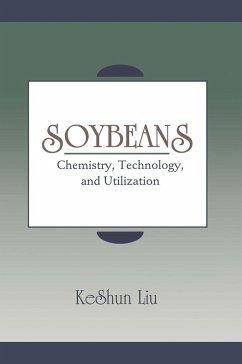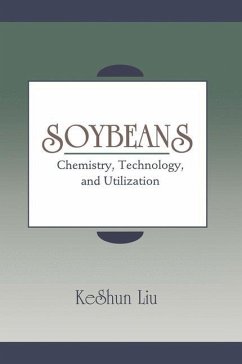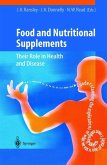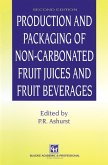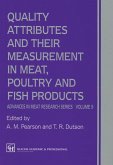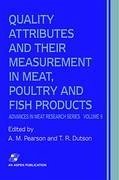- Gebundenes Buch
- Merkliste
- Auf die Merkliste
- Bewerten Bewerten
- Teilen
- Produkt teilen
- Produkterinnerung
- Produkterinnerung
Soybeans and soyfoods have become an increasingly important asset to people throughout the world, thanks in part to improvements in quality and quantity brought on by advancements in processing and breeding technology, and in part to their potential health benefits revealed by recent medical research.
Andere Kunden interessierten sich auch für
![Soybeans Soybeans]() KeShun LiuSoybeans38,99 €
KeShun LiuSoybeans38,99 €![Processed Apple Products Processed Apple Products]() Processed Apple Products38,99 €
Processed Apple Products38,99 €![Food and Nutritional Supplements Food and Nutritional Supplements]() Food and Nutritional Supplements38,99 €
Food and Nutritional Supplements38,99 €![Production and Packaging of Non-Carbonated Fruit Juices and Fruit Beverages Production and Packaging of Non-Carbonated Fruit Juices and Fruit Beverages]() Production and Packaging of Non-Carbonated Fruit Juices and Fruit Beverages39,99 €
Production and Packaging of Non-Carbonated Fruit Juices and Fruit Beverages39,99 €![Quality Attributes and their Measurement in Meat, Poultry and Fish Products Quality Attributes and their Measurement in Meat, Poultry and Fish Products]() A. M. PearsonQuality Attributes and their Measurement in Meat, Poultry and Fish Products38,99 €
A. M. PearsonQuality Attributes and their Measurement in Meat, Poultry and Fish Products38,99 €![Quality Attributes and Their Measurement in Meat, Poultry and Fish Products Quality Attributes and Their Measurement in Meat, Poultry and Fish Products]() A. M. PearsonQuality Attributes and Their Measurement in Meat, Poultry and Fish Products153,99 €
A. M. PearsonQuality Attributes and Their Measurement in Meat, Poultry and Fish Products153,99 €![Nutritional and Toxicological Significance of Enzyme Inhibitors in Foods Nutritional and Toxicological Significance of Enzyme Inhibitors in Foods]() Mendel FriedmanNutritional and Toxicological Significance of Enzyme Inhibitors in Foods77,99 €
Mendel FriedmanNutritional and Toxicological Significance of Enzyme Inhibitors in Foods77,99 €-
-
-
Soybeans and soyfoods have become an increasingly important asset to people throughout the world, thanks in part to improvements in quality and quantity brought on by advancements in processing and breeding technology, and in part to their potential health benefits revealed by recent medical research.
Hinweis: Dieser Artikel kann nur an eine deutsche Lieferadresse ausgeliefert werden.
Hinweis: Dieser Artikel kann nur an eine deutsche Lieferadresse ausgeliefert werden.
Produktdetails
- Produktdetails
- Verlag: Springer
- Seitenzahl: 564
- Erscheinungstermin: 31. Dezember 1995
- Englisch
- Abmessung: 235mm x 157mm x 36mm
- Gewicht: 960g
- ISBN-13: 9780412081217
- ISBN-10: 0412081210
- Artikelnr.: 66475762
- Herstellerkennzeichnung
- Libri GmbH
- Europaallee 1
- 36244 Bad Hersfeld
- gpsr@libri.de
- Verlag: Springer
- Seitenzahl: 564
- Erscheinungstermin: 31. Dezember 1995
- Englisch
- Abmessung: 235mm x 157mm x 36mm
- Gewicht: 960g
- ISBN-13: 9780412081217
- ISBN-10: 0412081210
- Artikelnr.: 66475762
- Herstellerkennzeichnung
- Libri GmbH
- Europaallee 1
- 36244 Bad Hersfeld
- gpsr@libri.de
1. Argonomic Characteristics, Production, and Marketing.- I. Origin.- II. Early History in Europe.- III. Early History in North America.- IV. Agronomic Characteristics.- V. Harvesting, Drying, and Storage.- VI. Marketing and Trading.- VII. Grades, Standards, and Inspection.- VII. Variety Identification.- IX. Food Beans and Oil Beans.- References.- 2. Chemistry and Nutritional Value of Soybean Components.- I. Proximate Composition.- II. Lipids.- III. Proteins.- IV. Carbohydrates.- V. Minor Components.- VI. Soy Hulls.- VII. Hypocotyl Axis.- References.- 3. Biological and Compositional Changes during Soybean Maturation, Storage, and Germination.- I. Changes during Soybean Maturation.- II. Biological Aging during Soybean Storage.- III. Changes during Soybean Germination.- 4. Nonfermented Oriental Soyfoods.- I. Soymilk.- II. Tofu.- III. Yuba.- IV. Other Nonfermented Soyfoods.- References.- 5. Fermented Oriental Soyfoods.- I. Fermented Soy Paste (Jiang and Miso).- II. Soy Sauce (Jiangyou or Shoyu).- III. Tempeh.- IV. Natto.- V. Soy Nuggets (Douchi or Hamanatto).- VI. Sufu.- References.- 6. Soybean Oil Extraction and Processing Andrew Proctor.- I. Preparation before Extraction.- II. Solvent Extraction.- III. Mechanical Extraction.- IV. Oil Refining.- V. Optional Additional Processing.- VI. Lecithin Processing.- VII. Plant and Environmental Safety.- References.- 7. Properties and Edible Applications of Soybean Oil.- I. General Properties of Soybean Oil.- II. Lipid Oxidation.- III. Various Types of Soybean Oil.- IV. Edible Applications of Soybean Oil.- V. Utilization of Soy Lecithin.- References.- 8. Soybean Protein Products Navam Hettiarachchy and Uruthira Kalapathy.- I. A Brief History of Soy Protein Products.- II. Types of Soy Protein Products and Processing.- III. Nutritional Quality of Soy Protein.- IV. Soy Protein as a Functional Ingredient.- V. Modification of Soy Proteins.- VI. Applications of Soy Protein Products.- VII. Challenges and Future Research.- References.- 9. The Second Generation of Soyfoods.- I. Dairy Analogs.- II. Meat Analogs.- III. Protein Texturization.- IV. Tofu-Based Foods and Ingredients.- References.- 10. Soyfoods: Their Role in Disease Prevention and Treatment.- I. Diet, Health, and Soyfoods.- II. Macronutrients in Soybeans.- III. Soy Isoflavones.- IV. Soy Intake and Cancer Risk.- V. Soy Intake and Osteoporosis.- VI. Soy Intake and Kidney Disease.- VII. Soy Intake and Heart Disease.- VIII. Soy Intake and Menopause.- IX. Potential Concerns Related to Soy Consumption.- X. Summary.- References.- 11. Soybean Improvements through Plant Breeding and Genetic Engineering.- I. The Breeding Process.- II. Breeding Methods.- III. Breeding to Increase Crop Productivity.- IV. Breeding for Food-Grade Soybeans.- V. Breeding to Increase Protein and Oil Content.- VI. Breeding to Improve Oil Quality.- VII. Breeding to Improve Protein Quality.- VIII. Breeding to Control Beany Flavor.- References.
1. Argonomic Characteristics, Production, and Marketing.- I. Origin.- II. Early History in Europe.- III. Early History in North America.- IV. Agronomic Characteristics.- V. Harvesting, Drying, and Storage.- VI. Marketing and Trading.- VII. Grades, Standards, and Inspection.- VII. Variety Identification.- IX. Food Beans and Oil Beans.- References.- 2. Chemistry and Nutritional Value of Soybean Components.- I. Proximate Composition.- II. Lipids.- III. Proteins.- IV. Carbohydrates.- V. Minor Components.- VI. Soy Hulls.- VII. Hypocotyl Axis.- References.- 3. Biological and Compositional Changes during Soybean Maturation, Storage, and Germination.- I. Changes during Soybean Maturation.- II. Biological Aging during Soybean Storage.- III. Changes during Soybean Germination.- 4. Nonfermented Oriental Soyfoods.- I. Soymilk.- II. Tofu.- III. Yuba.- IV. Other Nonfermented Soyfoods.- References.- 5. Fermented Oriental Soyfoods.- I. Fermented Soy Paste (Jiang and Miso).- II. Soy Sauce (Jiangyou or Shoyu).- III. Tempeh.- IV. Natto.- V. Soy Nuggets (Douchi or Hamanatto).- VI. Sufu.- References.- 6. Soybean Oil Extraction and Processing Andrew Proctor.- I. Preparation before Extraction.- II. Solvent Extraction.- III. Mechanical Extraction.- IV. Oil Refining.- V. Optional Additional Processing.- VI. Lecithin Processing.- VII. Plant and Environmental Safety.- References.- 7. Properties and Edible Applications of Soybean Oil.- I. General Properties of Soybean Oil.- II. Lipid Oxidation.- III. Various Types of Soybean Oil.- IV. Edible Applications of Soybean Oil.- V. Utilization of Soy Lecithin.- References.- 8. Soybean Protein Products Navam Hettiarachchy and Uruthira Kalapathy.- I. A Brief History of Soy Protein Products.- II. Types of Soy Protein Products and Processing.- III. Nutritional Quality of Soy Protein.- IV. Soy Protein as a Functional Ingredient.- V. Modification of Soy Proteins.- VI. Applications of Soy Protein Products.- VII. Challenges and Future Research.- References.- 9. The Second Generation of Soyfoods.- I. Dairy Analogs.- II. Meat Analogs.- III. Protein Texturization.- IV. Tofu-Based Foods and Ingredients.- References.- 10. Soyfoods: Their Role in Disease Prevention and Treatment.- I. Diet, Health, and Soyfoods.- II. Macronutrients in Soybeans.- III. Soy Isoflavones.- IV. Soy Intake and Cancer Risk.- V. Soy Intake and Osteoporosis.- VI. Soy Intake and Kidney Disease.- VII. Soy Intake and Heart Disease.- VIII. Soy Intake and Menopause.- IX. Potential Concerns Related to Soy Consumption.- X. Summary.- References.- 11. Soybean Improvements through Plant Breeding and Genetic Engineering.- I. The Breeding Process.- II. Breeding Methods.- III. Breeding to Increase Crop Productivity.- IV. Breeding for Food-Grade Soybeans.- V. Breeding to Increase Protein and Oil Content.- VI. Breeding to Improve Oil Quality.- VII. Breeding to Improve Protein Quality.- VIII. Breeding to Control Beany Flavor.- References.

